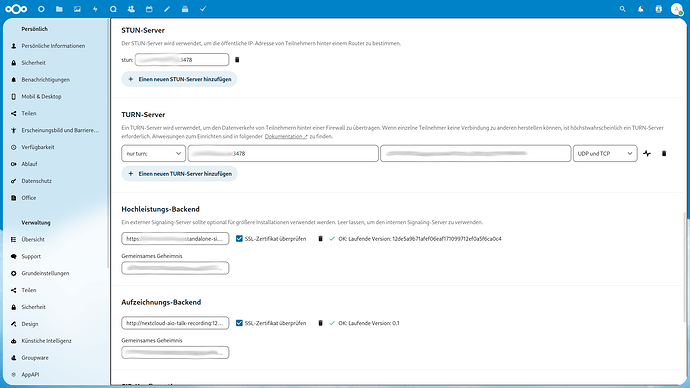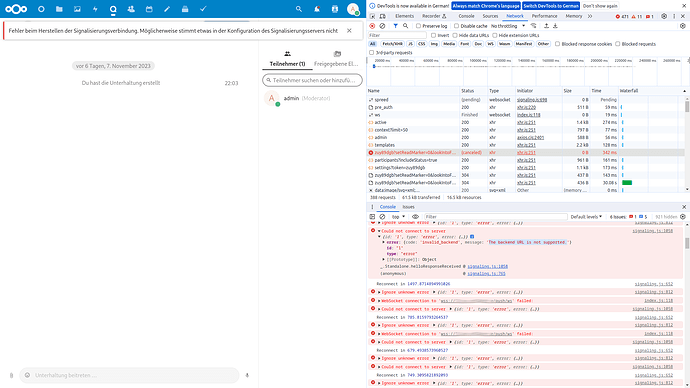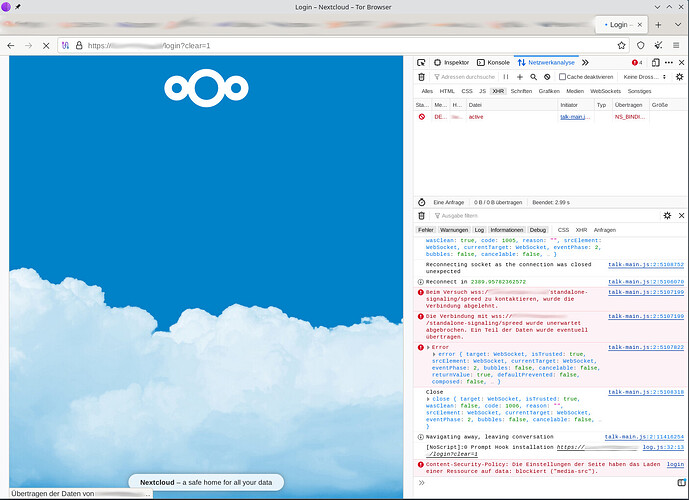Hello ![]()
I am a newbie to the use and implementation of Nextcloud-AIO. Very very nice !
I made use of the All-in-One VM image,
no proxy and setup with daily backup & automatic updates.
Unfortunately, a constant error occurs regarding Talk, that it cannot connect to server:
Der Aufbau der Signaling-Verbindung dauert länger als erwartet…
Fehler beim Herstellen der Signalisierungsverbindung. Möglicherweise stimmt etwas in der Konfiguration des Signalisierungsservers nicht
@AIO-Interface:
Talk (Running)
Talk Recording (Running)
@Administration
Talk Settings:
- STUN-Server
- TURN-Server
- Hochleistungs-Backend
- Aufzeichnungs-Backend show no failure
Result of
| $ curl -vvv https://[DOMAIN.COM]:443/standalone-signaling/api/v1/welcome |
|---|
| * Trying [SERVERIP]:443… |
| * Connected to [DOMAIN.COM] ([SERVERIP]) port 443 |
| * ALPN: curl offers h2,http/1.1 |
| * TLSv1.3 (OUT), TLS handshake, Client hello (1): |
| * CAfile: /etc/ssl/certs/ca-certificates.crt |
| * CApath: none |
| * TLSv1.3 (IN), TLS handshake, Server hello (2): |
| * TLSv1.3 (IN), TLS handshake, Encrypted Extensions (8): |
| * TLSv1.3 (IN), TLS handshake, Certificate (11): |
| * TLSv1.3 (IN), TLS handshake, CERT verify (15): |
| * TLSv1.3 (IN), TLS handshake, Finished (20): |
| * TLSv1.3 (OUT), TLS change cipher, Change cipher spec (1): |
| * TLSv1.3 (OUT), TLS handshake, Finished (20): |
| * SSL connection using TLSv1.3 / TLS_AES_128_GCM_SHA256 |
| * ALPN: server accepted h2 |
| * Server certificate: |
| * subject: CN=[DOMAIN.COM] |
| * start date: Oct 24 17:56:12 2023 GMT |
| * expire date: Jan 22 17:56:11 2024 GMT |
| * subjectAltName: host “[DOMAIN.COM]” matched cert’s “[DOMAIN.COM]” |
| * issuer: C=US; O=Let’s Encrypt; CN=R3 |
| * SSL certificate verify ok. |
| * TLSv1.3 (IN), TLS handshake, Newsession Ticket (4): |
| * using HTTP/2 |
| * [HTTP/2] [1] OPENED stream for https://[DOMAIN.COM]:443/standalone-signaling/api/v1/welcome |
| * [HTTP/2] [1] [:method: GET] |
| * [HTTP/2] [1] [:scheme: https] |
| * [HTTP/2] [1] [:authority: [DOMAIN.COM]] |
| * [HTTP/2] [1] [:path: /standalone-signaling/api/v1/welcome] |
| * [HTTP/2] [1] [user-agent: curl/8.4.0] |
| * [HTTP/2] [1] [accept: */*] |
| > GET /standalone-signaling/api/v1/welcome HTTP/2 |
| > Host: [DOMAIN.COM] |
| > User-Agent: curl/8.4.0 |
| > Accept: */* |
| > |
| < HTTP/2 200 |
| < alt-svc: h3=“:443”; ma=2592000 |
| < content-type: application/json; charset=utf-8 |
| < date: Mon, 13 Nov 2023 11:57:02 GMT |
| < server: Caddy |
| < server: nextcloud-spreed-signaling/12de5a9b71afef06eaf171099712ef0a5f6ca0c4 |
| < x-spreed-signaling-features: audio-video-permissions, hello-v2, incall-all, mcu, simulcast, switchto, transient-data, update-sdp, welcome |
| < content-length: 94 |
| < |
| {“nextcloud-spreed-signaling”:“Welcome”,“version”:“12de5a9b71afef06eaf171099712ef0a5f6ca0c4”} |
| * Connection #0 to host [DOMAIN.COM] left intact |
Log of the nextcloud-aio-talk container:
| https://[DOMAIN.COM]:8443/api/docker/logs?id=nextcloud-aio-talk |
|---|
| ++ dig nextcloud-aio-talk IN A +short ++ grep ‘[1]+$’ |
| ++ head -n1 |
| ++ sort |
| IPv4_ADDRESS_TALK=172.18.0.3 ++ dig nextcloud-aio-talk AAAA +short ++ grep ‘[2]+$’++ ++ sort head -n1 |
| IPv6_ADDRESS_TALK= |
| set +x Exec: /opt/eturnal/erts-14.0.2/bin/erlexec -noinput +Bd -boot /opt/eturnal/releases/1.12.0/start -mode embedded -boot_var SYSTEM_LIB_DIR /opt/eturnal/lib -config /opt/eturnal/releases/1.12.0/sys.config -args_file /opt/eturnal/releases/1.12.0/vm.args -erl_epmd_port 3470 -start_epmd false – foreground Root: /opt/eturnal |
| rnal |
| [27] 2023/11/13 04:02:06.438144 [INF] Starting nats-server |
| [27] 2023/11/13 04:02:06.441151 [INF] Version: 2.10.3 |
| [27] 2023/11/13 04:02:06.441153 [INF] Git: [1528434] |
| [27] 2023/11/13 04:02:06.441155 [INF] Name: NAAJ4IULGZSXDTKSEQJM6OFLGIBKVCM5YHKLQGN62OT27QLADTU4L7GQ |
| [27] 2023/11/13 04:02:06.441160 [INF] ID: NAAJ4IULGZSXDTKSEQJM6OFLGIBKVCM5YHKLQGN62OT27QLADTU4L7GQ |
| [27] 2023/11/13 04:02:06.441167 [INF] Using configuration file: /etc/nats.conf |
| [27] 2023/11/13 04:02:06.453493 [INF] Listening for client connections on 127.0.0.1:4222 |
| [27] 2023/11/13 04:02:06.453501 [INF] Server is ready |
| Janus commit: 22298e847202d7ae6e60a0592130b6f96752789e |
| Compiled on: Fri Oct 27 11:14:22 UTC 2023 |
| Logger plugins folder: /usr/local/lib/janus/loggers |
| Starting Meetecho Janus (WebRTC Server) v0.14.0 |
| Checking command line arguments… |
| Debug/log level is 3 |
| Debug/log timestamps are disabled |
| Debug/log colors are disabled |
| [WARN] Janus is deployed on a private address (172.18.0.3) but you didn’t specify any STUN server! Expect trouble if this is supposed to work over the internet and not just in a LAN… |
| [WARN] libcurl not available, Streaming plugin will not have RTSP support |
| [WARN] libogg not available, Streaming plugin will not have file-based Opus streaming |
| main.go:133: Starting up version 12de5a9b71afef06eaf171099712ef0a5f6ca0c4/go1.20.5 as pid 28 |
| main.go:142: Using a maximum of 3 CPUs |
| natsclient.go:108: Connection established to nats://127.0.0.1:4222 (NAAJ4IULGZSXDTKSEQJM6OFLGIBKVCM5YHKLQGN62OT27QLADTU4L7GQ) |
| grpc_common.go:167: WARNING: No GRPC server certificate and/or key configured, running unencrypted |
| grpc_common.go:169: WARNING: No GRPC CA configured, expecting unencrypted connections |
| backend_storage_static.go:72: Backend backend-1 added for https://[DOMAIN.COM]/ |
| hub.go:200: Using a maximum of 8 concurrent backend connections per host |
| hub.go:207: Using a timeout of 10s for backend connections |
| hub.go:303: Not using GeoIP database |
| main.go:228: Could not initialize janus MCU (dial tcp 127.0.0.1:8188: connect: connection refused) will retry in 1s |
| [WARN] No Unix Sockets server started, giving up… |
| [WARN] The ‘janus.transport.pfunix’ plugin could not be initialized |
| mcu_janus.go:294: Connected to Janus WebRTC Server 0.14.0 by Meetecho s.r.l. |
| mcu_janus.go:300: Found JANUS VideoRoom plugin 0.0.9 by Meetecho s.r.l. |
| mcu_janus.go:305: Data channels are supported |
| mcu_janus.go:309: Full-Trickle is enabled |
| mcu_janus.go:311: Maximum bandwidth 1048576 bits/sec per publishing stream |
| mcu_janus.go:312: Maximum bandwidth 2097152 bits/sec per screensharing stream |
| mcu_janus.go:318: Created Janus session 6821307493612106 |
| mcu_janus.go:325: Created Janus handle 1522041572882229 |
| main.go:263: Using janus MCU |
| hub.go:385: Using a timeout of 10s for MCU requests |
| backend_server.go:111: No IPs configured for the stats endpoint, only allowing access from 127.0.0.1 |
| main.go:339: Listening on 0.0.0.0:8081 |
| client.go:284: Client from [CLIENTIP] has RTT of 151 ms (151.414891ms) |
| client.go:284: Client from [CLIENTIP] has RTT of 112 ms (112.687309ms) |
| client.go:284: Client from [CLIENTIP] has RTT of 94 ms (94.838008ms) |
| client.go:284: Client from [CLIENTIP] has RTT of 107 ms (107.658469ms) |
| client.go:284: Client from [CLIENTIP] has RTT of 409 ms (409.641487ms) |
| client.go:284: Client from [CLIENTIP] has RTT of 213 ms (213.879134ms) |
| client.go:284: Client from [CLIENTIP] has RTT of 426 ms (426.639512ms) |
| client.go:284: Client from [CLIENTIP] has RTT of 283 ms (283.914738ms) |
| client.go:284: Client from [CLIENTIP] has RTT of 122 ms (122.435144ms) |
| client.go:284: Client from [CLIENTIP] has RTT of 218 ms (218.577487ms) |
| client.go:284: Client from [CLIENTIP] has RTT of 372 ms (372.43193ms) |
| client.go:284: Client from [CLIENTIP] has RTT of 18 ms (18.36552ms) |
| client.go:284: Client from [CLIENTIP] has RTT of 16 ms (16.601217ms) |
| client.go:284: Client from [CLIENTIP] has RTT of 18 ms (18.548559ms) |
| client.go:284: Client from [CLIENTIP] has RTT of 18 ms (18.26575ms) |
| client.go:284: Client from [CLIENTIP] has RTT of 18 ms (18.064661ms) |
| client.go:284: Client from [CLIENTIP] has RTT of 17 ms (17.968451ms) |
Where else could I look ? Is there anything I might have missed regarding “All-in-One VM image” and “Talk” ?
Your support would be greatly appreciated.
Best regards, Ive
Using: All-in-One VM image
https://download.nextcloud.com/aio-vm/
Nextcloud Hub 6 (27.1.3)
Nextcloud AIO v7.5.1
Using the integrated
Daily backup and automatic updates




